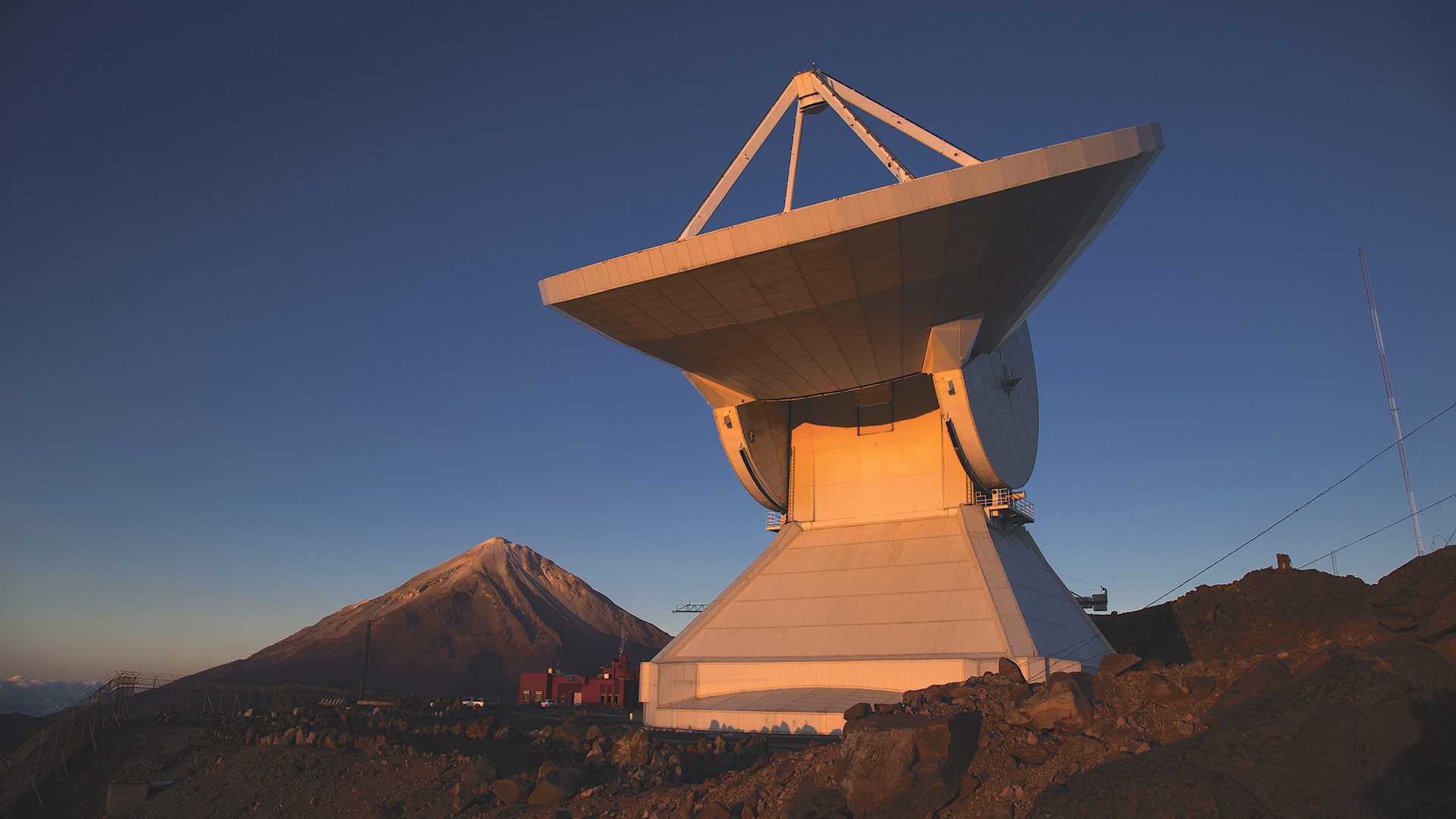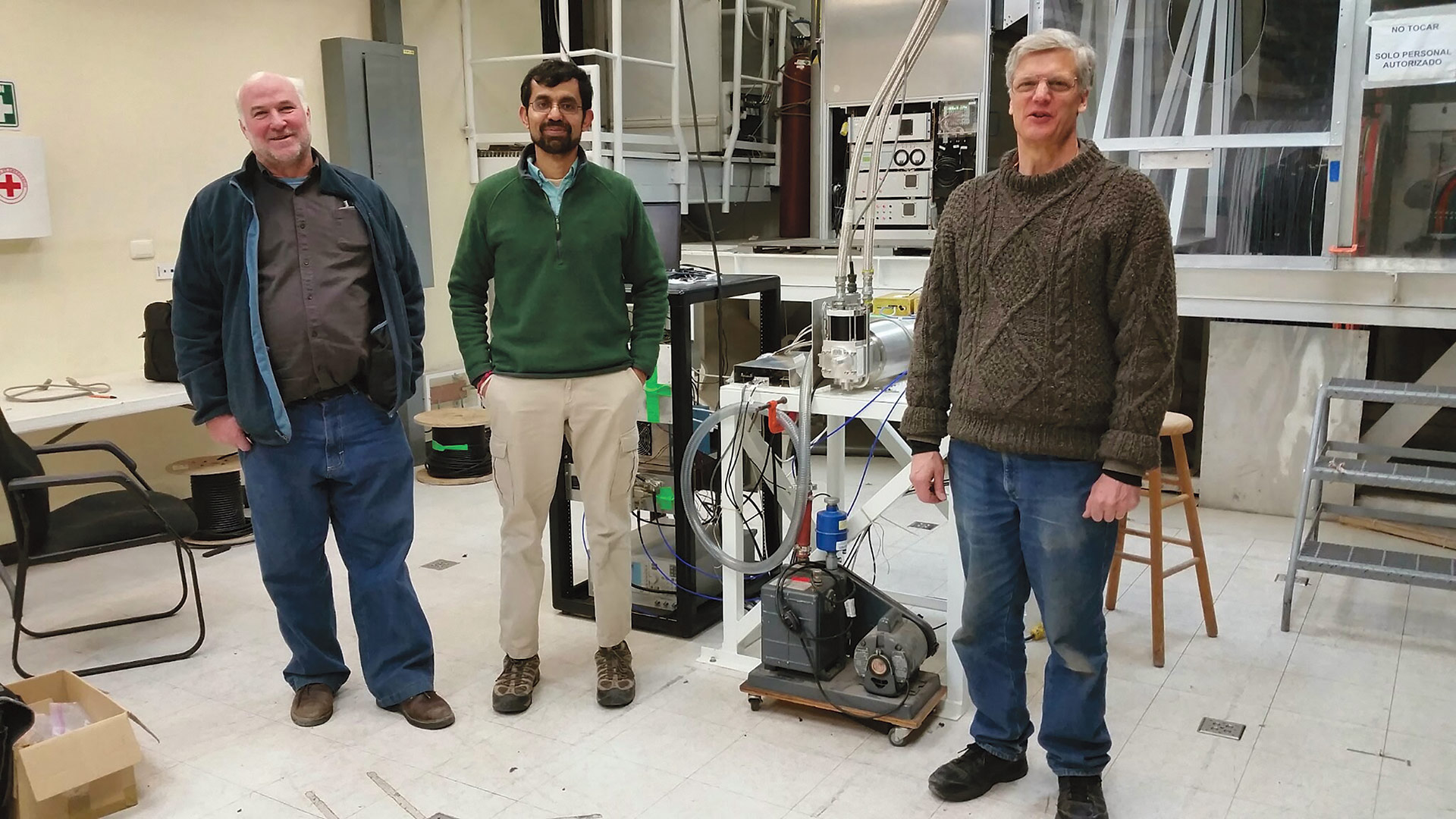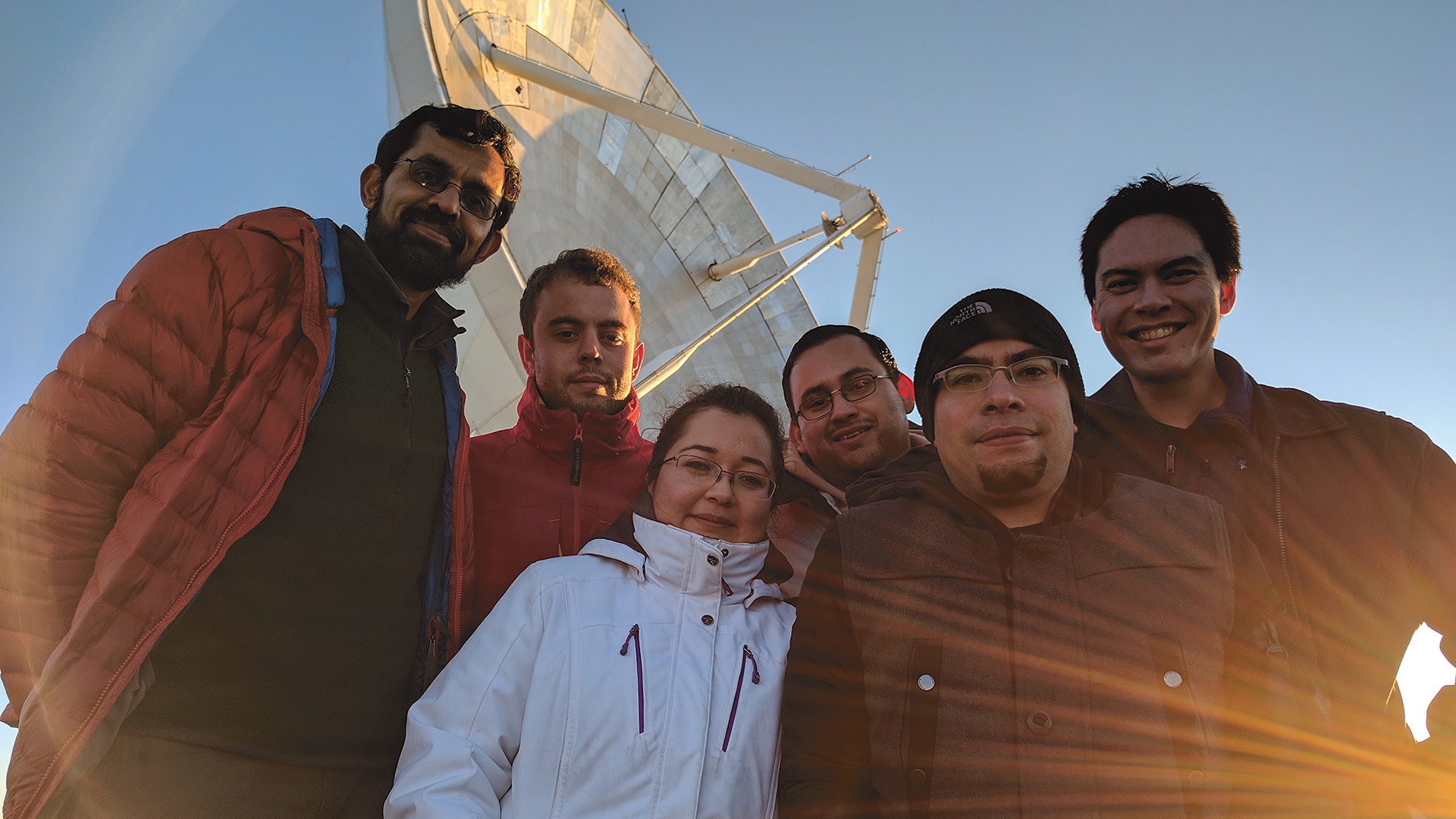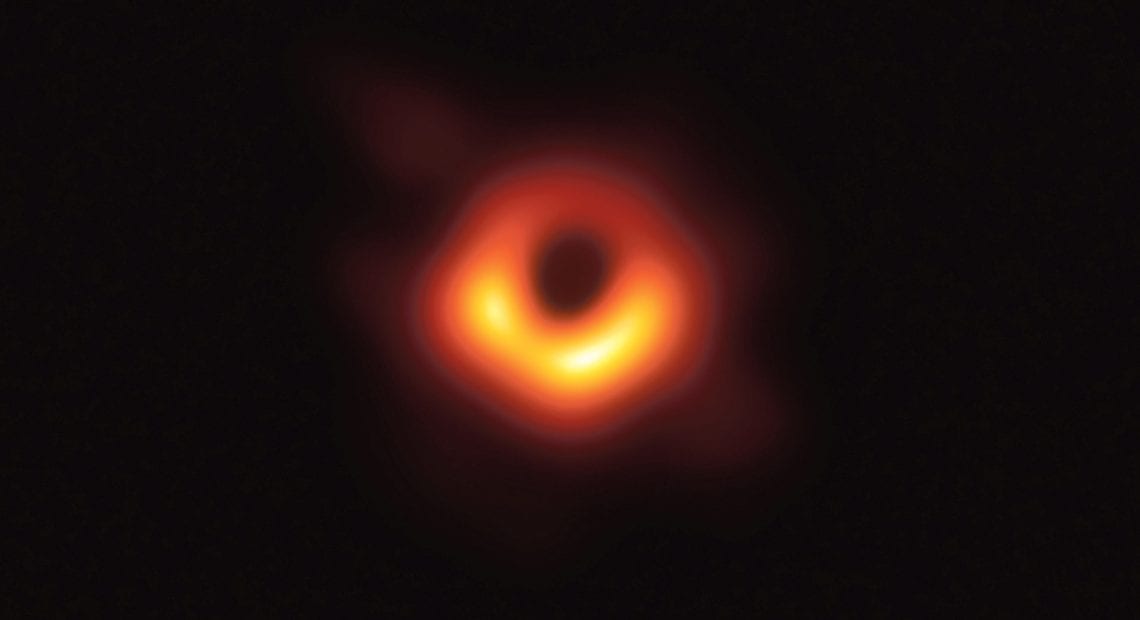The Stars Were Aligned
The image of the black hole in the center of the galaxy known as M87 that was released earlier this month was a groundbreaking development in many respects. It was the first direct visual evidence of a black hole, and it validated Einstein’s century-old theories of relativity. But it also put the spotlight on astronomers at UMass Amherst and a telescope, known as the LMT, that the university operates in partnership with the Mexican government.
Gopal Narayanan wasn’t totally sure, but he recalls that his gut told him “that we had … something.”
‘We’ is the collective that Narayanan, a research Astronomy professor at UMass Amherst, used to describe both his team stationed in April 2017 at the LMT (Large Millimeter Telescope) erected atop a 15,000-foot-high volcano in southern Mexico, and teams at seven other telescopes around the world. And the ‘something,’ as the world now knows, was what would become the first direct visual evidence of a supermassive black hole and its shadow.
Indeed, after a series of new conferences staged around the world announced the breakthrough on April 10, media outlets published what many would call a ‘photograph’ (see above) of the black hole at the center of Messier 87, or M87, as it’s called, a massive galaxy in the Virgo galaxy cluster, some 55 million light years from Earth.
It’s not a photograph in the traditional sense of the word, said Narayanan, but rather, as he’ll explain later, what amounts to a mathematical interpretation of data retrieved from those eight radio telescopes, known collectively as the Event Horizon Telescope, or EHT, a name that denotes the point at which light, matter, and other energy fall into a black hole.

From left: Aleks Popsefanija, Gopal Narayanan, and Peter Schloerb, members of the team at UMass Amherst that helped capture that first image of a black hole.
While most of the world’s focus has been on that image, what it shows, and what it means — essentially validation of Einstein’s theories of relatively forged nearly a century ago — the collaborative effort that produced that image is an equally compelling and far-less-known story.
As is the large contribution made by UMass Amherst astronomers and the LMT, a facility the university operates jointly with Mexico’s Instituto Nacional de Astrofisica, Óptica y Electrónica (INAOE).
The LMT, at 50 meters in diameter, more than half a football field, is the world’s largest single-dish, steerable, millimeter-wavelength telescope in the world, said Peter Schloerb, UMass Amherst’s LMT principal investigator professor, and early on, those working to create the EHT recognized that it could play a vital role in those efforts.
Specifically, an initiative to create what would be become, in effect, a telescope the size of the planet, Schloerb went on, adding that, by combining results from large telescopes scattered across the globe, those searching for a black hole could create a virtual telescope some 9,000 kilometers in diameter.
“It’s quite rare to get eight telescopes scattered around the world in completely different geographic locations — northern and southern hemispheres, east and west — to all have good weather for a stretch of several days, which we did. And you also need to have all the telescopes working technically well, which we did. It took a lot of doing, and there was a lot of preparatory work that had to be done for this campaign.”
“Such a telescope would have the resolution power to detect an orange on the surface of the moon or read the words on a quarter held up in Los Angeles — from Washington, D.C.,” said Schloerb, adding that getting this global telescope network in sync is a huge feat.
Narayanan agreed, noting that, to eventually create that image broadcast to the world earlier this month — nearly two years after the data was actually collected — all eight telescopes had to be operating in perfect weather and with all instrumentation functioning properly, a difficult assignment, especially for the four-day window that was needed.
“It’s quite rare to get eight telescopes scattered around the world in completely different geographic locations — northern and southern hemispheres, east and west — to all have good weather for a stretch of several days, which we did,” he explained. “And you also need to have all the telescopes working technically well, which we did. It took a lot of doing, and there was a lot of preparatory work that had to be done for this campaign.”
In many ways, the image of the M87 black hole justifies decades of hard work at the LMT, a facility located in a challenging environment that has seen its share of struggles over the years, noted Narayanan, adding that the project puts the full potential of the facility on display.
“This is a fantastic validation of all the effort we have put in on the LMT,” he said. “It shows that the telescope works and that it can do ground-breaking science.”

The LMT (Large Millimeter Telescope) in Mexico is operated jointly by UMass Amherst and Mexico’s Instituto Nacional de Astrofisica, Óptica y Electrónica.
And the LMT will certainly play a large role in what will hopefully happen next when it comes to capturing images of black holes, said Narayanan. This includes attaining similar images of the black hole at the center of the galaxy known as Sagittarius A* — data is still being collected on it — and it might also include what he called a movie of a black hole — again, not one in the traditional sense (more on that later).
For this issue, BusinessWest talked at length with Narayanan, Schloerb, and astronomy graduate student Aleks Popsefanija about the black-hole project and what will likely come next.
It’s All Relative
Returning to the subject of those observations captured by the EHT, Narayanan said they reveal the image of a black hole and the event horizon surrounding it.
The bright yellow and gold colors seen in the bright ring, which results from the incredible pull the black hole exerts on nearby matter, are not real, he told BusinessWest. They were chosen to convey the intensity of the emissions.
“Typically, astronomers use orangish-red hues to show when things are hot,” he explained. “These are super-hot objects around the black hole.”
This image has been literally decades in the making, he went on, adding that, while scientists have long coveted visual proof of a black hole to validate long-held theories on these mysterious and massively powerful objects, until recently, attaining one was merely a pipe dream.
The key to making it reality is the EHT and an earth-sized telescope it creates, said Popsefanija, an Amherst native who told BusinessWest that, after earning a degree in physics at Carnegie Mellon University in 2014, he was looking for a job, and his search took him the Astronomy department at UMass Amherst. Just a few years later, he would be part of the team at the LMT that made history.
And part of a larger team that would work in sync to gather and coordinate the data from those eight telescopes, which was, as noted, as almost herculean feat.
At the heart of it all is a 1-millimeter-length receiver built for the LMT that would be used to collect the EHT data. Essentially, this receiver, what Narayanan called a “super-conducting mixer” not built specifically for this purpose, takes signals from the black hole, brings them to lower frequencies, digitizes the signals, and sends them on to data recorders.
This same work was being done at the other seven telescopes simultaneously, he went on, adding that synchronizing the telescope network was an exercise in extreme precision, to say the least.

The engineering team responsible for building the 1-millimeter receiver that was installed on the LMT and used for the EHT campaign. From left to right, Joe Crowley (MIT Haystack), Gopal Narayanan (UMass), and Ron Grosslein (UMass).
“We had to have very accurate timing in the collection of data,” he explained. “We had to know when the signals arrived at each telescope to a precision of a nanosecond, which is one-billionth of a second.”
So, to get the image that was eventually shared with the world earlier this month, the stars have to be aligned, in every sense of that phrase, said Narayanan, from the weather to the instrumentation. And those weren’t the only challenges to be faced.
Indeed, at 15,000 feet, the view from the LMT is spectacular — for telescopes, as well as the people working at one — but it’s difficult working at that altitude, said Narayanan, adding that one can remain at that elevation for maybe a dozen hours because there is far less oxygen than there is at sea level.
“Every step you take is hard, and thinking is hard, because your brain lacks oxygen,” he explained, adding that these conditions necessitated the need for two teams that would work in shifts at the telescope. “You always question any action you take, and it’s very strenuous work. At the same time, driving up the mountain and seeing the entire world beneath you, seeing the clouds beneath you, is a wonderful and emotional experience as well.”
Through all of that, Narayanan had that gut feeling that the teams working at those telescopes around the globe had ‘something.’
“I had a great deal of confidence that we had collected great data,” he explained, adding that this data then had to be analyzed and vetted, a lengthy, nearly two-year-long process during which astronomers had to keep quiet about their groundbreaking discovery.
Coming into Focus
With that, Narayanan explained how the image was attained. As for what it shows — that asymmetric ring-like structure around a central dark region — this is equally groundbreaking.
Indeed, the findings, as laid out in six papers published in a special issue of the Astrophysical Journal Letters, essentially support Einstein’s theories of relativity and confirm what scientists have long theorized about black holes without actually ever seeing one.
“Professor Einstein’s work has stood the test of time,” he said. “It’s been nearly 100 years since he came up with the two relativity theories — a special theory of relativity dealing with traveling near the speed of light and a general theory of relativity to do with gravitation. Black holes are direct predictions from his GR, general relativity theory, and multiple experiments show the theory works, and works in extreme regimes.
“But this particular regime, a 6-million-solar-mass black hole, was thought to be a place that would really test the limits of that theory,” he went on. “Our big hope was that we would obtain an image that would conclusively prove there is a black hole, and that was without a doubt the case, and that’s the sweet part of this.”

Part of the team in front of the LMT. From left, Gopal Narayanan, Aleks Popstefanija, Sandra Bustamante, Antonio Hernandez (Crya, Morelia, Mexico), David Sanchez, and Lindy Blackburn.
This is uplifting in many respects, said Narayanan, before adding quickly that he would likely have been equally excited, if not more so, if the evidence didn’t support those long-held theories.
“Perhaps if we had found something that violated the predictions of Einstein’s theories of relativity, we would come up in new, uncharted territory that makes us rethink the theories,” he told BusinessWest. “And that’s the way we basically make progress.
“You make a model of the universe and go out and observe to see if that model can be validated by actual observations, which is reality,” he went on. “And then you find out that the theory is not quite right because the observations belie the earlier predictions; that’s how you make progress. That’s not to say we didn’t make any progress — we made a lot of progress.”
And in a many different ways, he said, adding that the M87 project has certainly laid the groundwork for further developments in the search for — and study of — black holes.
And also in the emergence of the LMT. UMass has been involved with that facility for 20 years now, said Narayanan, who offered a quick history lesson.
He said UMass was one of the birthplaces of the pioneering field known as millimeter-wave astronomy back in the 1970s. As part of that effort, the university’s Astronomy department built a 14-millimeter radio telescope just north of the Quabbin Reservoir called the Five College Radioastronomy Observatory, which it operated until roughly 10 years ago, providing training for a few generations of students.
Years ago, it became apparent that the department had achieved about all it could with a facility of that size and commenced a search for a larger telescope. That search led to a partnership with the Mexican government and specifically the INAOE, and eventually the construction of the LMT, which saw what the industry calls ‘first light’ in 2010.
The first receiver built onto it was designed not to look at black holes, but rather the first galaxies to be created after the Big Bang.
The chosen site, the Sierra Negra volcano in the Mexican state of Puebla, brings many benefits, including location (close to the equator), that made it a pivotal piece of the EMT puzzle, said Narayanan, adding that its performance in that project bodes well for the future.
And that includes more work on black holes, including the one in Sagittarius A*, a much smaller black hole than that at M87, with a 4 million solar mass. Astronomers are still collecting data on that object, said Narayanan, adding that there many additional challenges (on top of those already mentioned) when it comes to observing and studying a black hole in the center of our galaxy.
“It’s a smaller black hole, so things move around faster,” he explained. “Also, looking through our galaxy itself produces some scattering of the light coming from the center of our galaxy. But we’re working through the data, and we should produce some results soon.”
As for that movie he mentioned, that may also become a reality through efforts to expand and enhance the EHT process through additional telescopes and other additions.
“We can make multiple images and stack them together to make a movie, as it were, of how things vary around a black hole,” he explained. “And that has fantastic scientific implications that will tell us a lot of things about black holes and the structure of our universe.”
Bottom Line
The image of the black hole at M87 that sped across the globe soon became the star of the show when it came to the groundbreaking discovery — pun intended.
But, in reality, there were many stars, including the teams of astronomers who collaborated on the project, and the LMT itself, a facility that, as Narayanan noted, has put its full talents on display.
Moving forward, the challenge — and the opportunity — lies in building on this breakthrough.
And the stars seem aligned for that to happen as well.
George O’Brien can be reached at [email protected]







